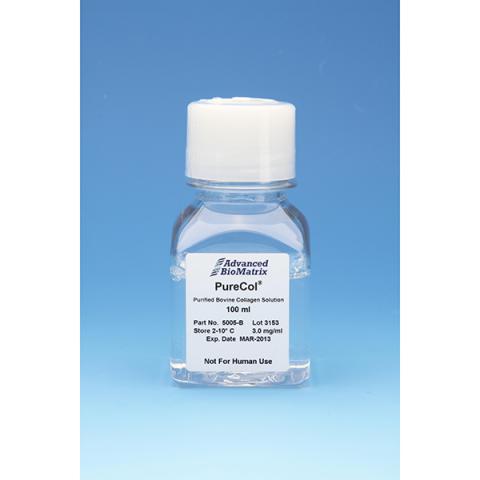商品描述
PureCol® collagen is known as the standard of all collagens for purity (>99.9% collagen content), functionality, and the most native-like collagen available. PureCol® is isolated from bovine hides sourced from the only controlled, closed herd in the United States. Advanced BioMatrix’s manufacturing processes comply with stringent quality standards that have proven to yield unsurpassed lot-to-lot consistency.
PureCol® collagen is approximately 97% Type I atelocollagen with the remainder being comprised of Type III collagen. PureCol® collagen is supplied at approximately a 3 mg/ml concentration. The concentration for each specific lot is provided on a Certificate of Analysis that is available with the purchase of each product. PureCol® is soluble atelocollagen in 0.01 N HCI, therefore, the pH is 2. PureCol® collagen is ideal for coating of surfaces, providing preparation of thin layers for culturing cells, or use as a solid gel.
PureCol® collagen is provided in a user-friendly packaging for use and storage. PureCol® is sterile filtered and is supplied as a ready to use solution.
| Parameter, Testing, and Method | PureCol® Type I Collagen #5005 |
| Sterilization Method | Filtration |
| Extraction Method | Enzyme - atelocollagen |
| Form | Solution |
| Package Size | 100 mL, 1000 mL |
| Storage Temperature | 2-10°C |
| Shelf Life | Minimum of 6 months from date of receipt |
|
Collagen Concentration - Biuret |
2.9-3.2 mg/mL |
|
Collagen Purity - Silver Staining |
>99.9% |
| pH | 1.9-2.1 |
| Kinetic Gel Test (Minutes) | <40 |
| Gel Formation Tube Test (Minutes) | < 40 |
|
Fibrillogenesis (Absorbance Units) |
>0.5 |
|
Electrophoretic Pattern - Coomassie Blue |
Characteristic |
| Sterility - USP modified | No growth |
| Endotoxin - LAL | <1.0 EU/mL |
| Osmolality (mOsmo H2O/kg) | <35 |
| Cell Attachment Assay | Pass |
| Source | Bovine Hide |
| Hydrogel Young's Modulus E (Pa) | Characteristic |
问题分析:
Reasons Your Collagen Might Not be Gelling
The pH is not neutral
Double check to make sure the pH is 7.0-7.4.
Even if using a neutralization solution, the pH may be off due to mixing issues or collagen "hold-up" in pipette tips, slightly altering the collagen:neutralization solution ratio.
Incorrect levels of salts
Ensure the salts of the neutralization collagen solution are isotonic (~300 mOsmo). We accomplish this by adding 1 part of 10X PBS or Media in most collagen hydrogel preparations.
Temperature
Collagen gels best at 37C. Ensure the temperature does not exceed 38.5C, as the collagen will begin to denature.
Collagen Concentration
Low collagen concentration solutions will have a hard time forming a gel. We recommend keeping the collagen concentration >1.5 mg/ml for best results.
Mechanical agitation
Vortexing the collagen solution can have negative impacts on the collagen and will negatively affect the ability of the solution to form a hydrogel. Do not vortex.
Do not agitate the collagen solution during incubation and gelation. This will interfere with the fibrillogenesis process.
Material was frozen or left at room temperature
If the collagen solution was frozen or left at room temperature for a long period of time, it may have begun to denature, which would affect its ability to gel.
Very small volumes of collagen were used in a non-confined space
We have found that using microliters of collagen on top of glass coverslips tend to not gel very well.
We recommend ensuring the collagen is within a confined space (ie. wells or walls)
Neutralization Solution came out of solution
If using a collagen product that comes with a neutralization solution, ensure that the neutralization solution is still fully in solution. Getting it too cold can cause it to come out of solution. If this happens, simply warm it back up.
Weights vs Volume
Due to pipette hold-up volume, dispensing 1 mL of collagen (3 mg/ml) using a pipettor actually only dispenses about .89 grams. For the most accurate results, we recommend usings weights for viscous materials, such as collagen. The neutralization solutions, buffers and medias can use volume, as their viscosity is close to water.
Expired material
Collagen tends to be stable when stored properly, but after a few years, the "gel strength" slowly declines. Expired collagen may still form hydrogels, but it will be significantly softer than a fresh batch of collagen.
Heat transfer
Warming collagen to 37C for polymerization in a test tube, in a water batch will be much more efficient than gelling collagen in an enclosed 6-well plate, with a lid, in a dry incubator. Look for ways to improve heat transfer if quicker polymerization is desired.
Mixing
Ensure proper mixing to create a homogeneous solution (without vortexing) for best results.
Lyophilized Collagen
Atelocollagen that has been lyophilized (such as lyophilized PureCol, catalog #5006), tends to form weaker hydrogels, or not polymerize at all.
Insoluble Collagen
Advanced BioMatrix offers two insoluble collagen products, #5162 and #5164. These collagen powders are extremely robust and will not fully go into solution.

